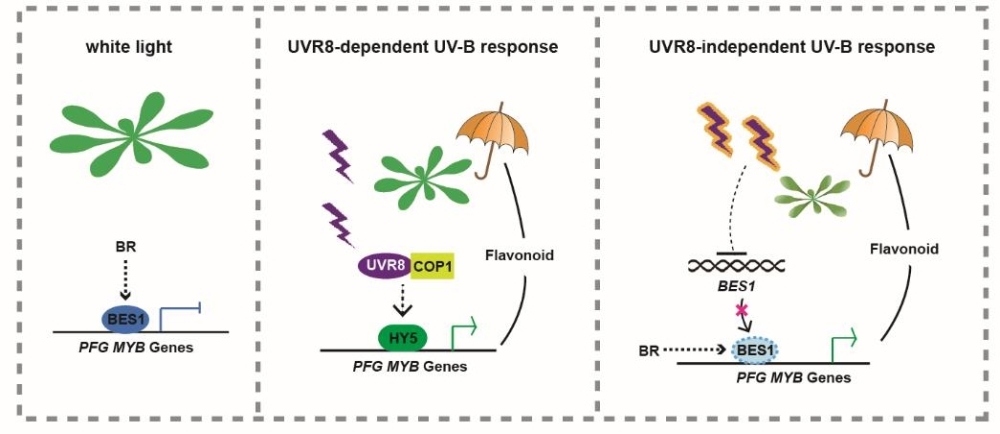A new study shows that BES1 coordinates growth and UV-B stress responses
Ultraviolet-B light (UV-B) is an inherent part of sunlight, which has significant biological effects on plants. Low level, non-damaging UV-B serves as a photomorphogenic signal to regulate photomorphogenesis. UV-B can damage DNA, trigger the accumulation of reactive oxygen species, and impair photosynthesis. Plants have evolved efficient mechanisms to prevent or limit UV-B-induced damage by accumulating “sunscreen” flavonoids, including flavonol, anthocyanins, and proanthocyanidins (PAs). UV-B induces the expression of flavonoid biosynthesis genes, and Arabidopsis thaliana mutants deficient in flavonoids are UV-B sensitive
A group led by Dr Hongtao Liu from CAS Center for Excellence in Molecular Plant Sciences provides evidence that BES1 mediates the tradeoff between plant growth and UV-B stress responses.
Their results indicate that brassinosteroid (BR) signaling inhibits UV-B stress responses in Arabidopsis thaliana and various crops by controlling flavonol biosynthesis. We further demonstrate that BRI1-EMS-SUPPRESSOR 1 (BES1) mediates the tradeoff between plant growth and UV-B defense responses. BES1, a master transcription factor involved in BR signaling, represses the expression of transcription factor genes MYB11, MYB12, and MYB111, which activate flavonol biosynthesis. BES1 directly binds to the promoters of these MYBs in a BR-enhanced manner to repress their expression, thereby reducing flavonol accumulation. However, exposure to broad-band UV-B down-regulates BES1 expression, thus promoting flavonol accumulation. These findings demonstrate that BR-activated BES1 not only promotes growth but also inhibits flavonoid biosynthesis. UV-B stress suppresses the expression of BES1 to allocate energy to flavonoid biosynthesis and UV-B stress responses, allowing plants to switch from growth to UV-B stress responses in a timely manner.
This work entitled “Brassinosteroid-Activated BRI1-EMS-SUPPRESSOR 1 Inhibits Flavonoid Biosynthesis and Coordinates Growth and UV-B Stress Responses in Plants” has been published online in The Plant Cell on August 7th. The research was funded by NSFC, MOST and CAS.

A working model describing UVR8-dependent and UVR8-independent stress responses.
When plants are grown without UV-B, BR signaling activates BES1 to repress the expression of PFG MYBs controlling flavonoid biosynthesis.
When plants are irradiated with narrow-band UV-B, photo-activated UVR8 interacts with COP1 to promote HY5 accumulation, thus initiating UV-B photomorphogenesis, including activating the expression of PFG MYBs.
When plants are irradiated with broad-band UV-B, in addition to activating UVR8-COP1-HY5 signaling, UV-B stress inhibits the expression of BES1 in an UVR8-independent manner to suppress the inhibition of PFG MYBs. Flavonoids act as sunscreen compounds to protect plant cells from UV-B stress. BR-activated BES1 mediates the tradeoff between plant growth and UV-B stress responses.
Link:http://www.plantcell.org/content/early/2020/08/13/tpc.20.00048
Contact:
Dr. Hongtao Liu, Professor
National Key Laboratory of Plant Molecular Genetics, CAS Center for Excellence in Molecular Plant Sciences/Shanghai Institute of Plant Physiology and Ecology (SIPPE), Chinese Academic of Sciences
Tel: 86-21-54924291
Email: htliu@cemps.ac.cn